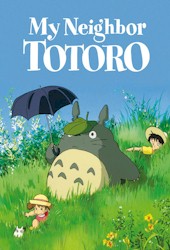My Neighbour Totoro
Directed By: Hayao Miyazaki
Story By: Hayao Miyazaki
Produced By: Toru Hara
Starring: Chika Sakamoto Noriko Hidaka Hitoshi Takagi
Cinematography By: Hisao Shirai
Edited By: Takeshi Seyama
Music By: Joe Hisaishi
Production Companies: Studio Ghibli
Release Date: April 16, 1988
Content: Youth

Plot: In 1950s Japan, university professor Tatsuo Kusakabe and his two daughters, Satsuki and Mei (approximately ten and four years old, respectively), move into an old house closer to the hospital where the girls' mother, Yasuko, is recovering from a long-term illness. The house is inhabited by small, dark, dust-like house spirits called susuwatari, which can be seen when moving from bright to dark places.[note 1] When the girls become comfortable in their new house, the susuwatari leave to find another empty house. One day, Mei discovers two small spirits who lead her into the hollow of a large camphor tree. She befriends a larger spirit, which identifies itself by a series of roars that she interprets as "Totoro". Mei thinks Totoro is the Troll from her illustrated book Three Billy Goats Gruff, with her mispronouncing Troll. She falls asleep atop Totoro, but when Satsuki finds her, she is on the ground. Despite many attempts, Mei cannot show her family Totoro's tree. Tatsuo comforts her by telling her that Totoro will reveal himself when he wants to.
One rainy night, the girls are waiting for Tatsuo's bus, which is late. Mei falls asleep on Satsuki's back, and Totoro appears beside them, allowing Satsuki to see him for the first time. Totoro has only a leaf on his head for protection against the rain, so Satsuki offers him the umbrella she had taken for her father. Delighted, he gives her a bundle of nuts and seeds in return. A giant, bus-shaped cat halts at the stop, and Totoro boards it and leaves. Shortly after, Tatsuo's bus arrives. A few days after planting the seeds, the girls awaken at midnight to find Totoro and his colleagues engaged in a ceremonial dance around the planted seeds and join in, causing the seeds to grow into an enormous tree. Totoro takes the girls for a ride on a magical flying top. In the morning, the tree is gone, but the seeds have sprouted.
End of Spoilers
Review: Studio Ghibli has come to represent the very best in anime and story telling. This wonderfully crafted fairy tale is no exception. As it colourfully portrays an adventure into what it means to be family and to be accepted.
In the 1950's a father takes his two daughters, Satsuki and Mei, to live in a small rural house that is closer to the hospital his wife is. She is receiving treatment for an ongoing illness. The story begins when the children discover there are small dusty spirits that inhabit the dark areas of the house. These dust spirits are called susuwatari in Japan. When the children feel at home the dust spirits leave.
One say Mei discovers two small spirits that lead here to a camphor tree where she meets and befriends a large friendly spirit she names Totoro, after the sound he makes when talking. The journey for the two sisters takes them through several fun encounters with Tororo and his spirit friends. While they each learn to deal with some of life's more challenging moments.
According to Eriko Ogihara-Schuck, animism plays a large part in this story. Totoro represents many of the interesting aspects of the Shinto religion. Through the various expressions of its' character we can see how the Shinto belief views such spirits. Somewhat different from many other belief systems. And certainly different from Christianity.
M J Flack
